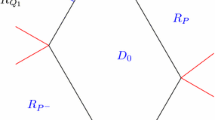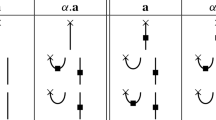Abstract
The affine Weyl group acts on the cohomology (with compact support) of affine Springer fibers (local Springer theory) and of parabolic Hitchin fibers (global Springer theory). In this paper, we show that in both situations, the action of the center of the group algebra of the affine Weyl group (the spherical part) factors through the action of the component group of the relevant centralizers. In the situation of affine Springer fibers, this partially verifies a conjecture of Goresky–Kottwitz–MacPherson and Bezrukavnikov–Varshavsky. We first prove this result for the global Springer action, and then deduce from it the result for the local Springer action. This gives an application of global Springer theory to more classical problems.
Similar content being viewed by others
Notes
This part of the argument was suggested by Y. Varshavsky.
The idea of proving Theorem 2 by duality of the type (40) was suggested by R. Bezrukavnikov.
References
Bernstein, J., Lunts, V.: Equivariant sheaves and functors. Lecture Notes in Mathematics, vol. 1578. Springer, Berlin (1994)
Bezrukavnikov, R.: The dimension of the fixed point set on affine flag manifolds. Math. Res. Lett. 3(2), 185–189 (1996)
Bezrukavnikov, R., Kazhdan, D., Varshavsky, Y.: On the stable center conjecture. arXiv:1307.4669
Bezrukavnikov, R., Varshavsky, Y.: Homology of affine Springer fibers, characters of Deligne–Lusztig representations, and stability (preprint)
Deligne, P.: Théorie de Hodge. III. Inst. Hautes Études Sci. Publ. Math. No. 44, 5–77 (1974)
Deligne, P.: La conjecture de Weil. II. Inst. Hautes Études Sci. Publ. Math. No. 52, 137–252 (1980)
Faltings, G.: Algebraic loop groups and moduli spaces of bundles. J. Eur. Math. Soc. 5, 41–68 (2003)
Gaitsgory, D.: Construction of central elements of the affine Hecke algebra via nearby cycles. Invent. Math. 144(2), 253–280 (2001)
Grothendieck, A., Illusie, L.: Formule de Lefschetz, Exposé III of SGA 5. In: Cohomologie \(\ell \)-adique et fonctions \(L\). Lecture Notes in Mathematics, vol. 589. Springer, Berlin (1977)
Kazhdan, D., Lusztig, G.: Fixed point varieties on affine flag manifolds. Israel J. Math. 62(2), 129–168 (1988)
Kottwitz, R.: Unpublished notes
Lusztig, G.: Affine Weyl groups and conjugacy classes in Weyl groups. Transform. Groups 1(1–2), 83–97 (1996)
Ngô, B.-C.: Fibration de Hitchin et endoscopie. Invent. Math. 164(2), 399–453 (2006)
Ngô, B.-C.: Decomposition theorem and abelian fibration. On the stabilization of the trace formula. Stab. Trace Formula Shimura Var. Arith. Appl., vol. 1. Int. Press, Somerville, pp. 253–264 (2011)
Ngô, B.-C.: Le lemme fondamental pour les algèbres de Lie. Publ. Math. Inst. Hautes Études Sci. No. 111, 1–169 (2010)
Olsson, M.: Sheaves on Artin stacks. J. Reine Angew. Math. 603, 55–112 (2007)
Saint-Donat, B.: Techniques de descente cohomologique, Exposé Vbis of SGA 4 II. Théorie des topos et cohomologie étale des schémas, Lecture Notes in Mathematics, vol. 270. Springer, Berlin (1972)
Serre, J.-P.: Corps locaux. Deuxième édition, Publications de l’Université de Nancago, No. VIII. Hermann, Paris (1968)
Springer, T.A.: Trigonometric sums, Green functions of finite groups and representations of Weyl groups. Invent. Math. 36, 173–207 (1976)
Yun, Z.: Global Springer Theory. Adv. Math. 228, 266–328 (2011)
Yun, Z.: Langlands duality and Global Springer theory. Composit. Math. 148, 835–867 (2012)
Yun, Z.: Towards a global Springer theory II: the double affine action (arXiv:0904.3371)
Acknowledgments
The author would like to thank R. Bezrukavnikov, B-C. Ngô and Y. Varshavsky for helpful discussions. He also appreciates the suggestions of the referee which improve the presentation of the paper. The author’s research is supported by the NSF grants DMS-0969470, DMS-1261660, DMS-1302071 and the Packard Foundation.
Author information
Authors and Affiliations
Corresponding author
Appendix A: Sheaves and correspondences on spaces locally of finite type
Appendix A: Sheaves and correspondences on spaces locally of finite type
In this appendix, all algebraic spaces are locally of finite type over \(k\).
1.1 A.1 The category of sheaves
Let \(X\) be an algebraic space over \(k\) which is locally of finite type. Let \(\mathrm{Ft}(X)\) be the set of open subsets \(U\subset X\) which are of finite type over \(k\). We define
When \(X\) itself is of finite type over \(k,\,\mathrm{Ft}(X)\) has a final object \(X\), so obviously \(\underleftarrow{D}^{b}(X)=D^{b}(X)\).
Concretely, an object in \(\underleftarrow{D}^{b}(X)\) is a system of complexes \({\mathcal {F}}_{U}\in D^{b}(U)\) for each open subset \(U\subset X\) of finite type over \(k\), together with isomorphisms \(\varphi ^{U}_{V}:j^{*}{\mathcal {F}}_{U}\mathop {\rightarrow }\limits ^{\sim }{\mathcal {F}}_{V}\) for each open embedding \(j:V\hookrightarrow U\) satisfying obvious transitivity conditions. A morphism \(\alpha :\{{\mathcal {F}}_{U}\}\rightarrow \{{\mathcal {G}}_{U}\}\) is a system of maps \(\alpha _{U}:{\mathcal {F}}_{U}\rightarrow {\mathcal {G}}_{U}\) in \(D^{b}(U)\) such that \(\alpha _{U}\) restricts to \(\alpha _{V}\) on \(V\).
Examples of objects in \(\underleftarrow{D}^{b}(X)\) include the constant sheaf \({\mathbb {Q}}_{\ell ,X}:=\{{\mathbb {Q}}_{\ell ,U}\}\) and the dualizing complex \({\mathbb {D}}_{X}:=\{{\mathbb {D}}_{U}\}\).
1.2 A.2 Functors
Let \(f:X\rightarrow Y\) be a morphism which is locally of finite type. We have the following functors
-
1.
\(f^{*}:\underleftarrow{D}^{b}(X)\rightarrow \underleftarrow{D}^{b}(Y)\). For \(U\in \mathrm{Ft}(X),\,f(U)\) is contained in some \(V\in \mathrm{Ft}(Y)\). Denote by \(f_{U,V}:U\rightarrow V\) the restriction of \(f\). We define \((f^{*}{\mathcal {G}})_{U}=f_{U,V}^{*}{\mathcal {G}}_{V}\).
-
2.
\(f^{!}:\underleftarrow{D}^{b}(X)\rightarrow \underleftarrow{D}^{b}(Y)\), defined in a similarly way as \(f^{*}\): \((f^{!}{\mathcal {G}})_{U}:=f_{U,V}^{!}{\mathcal {G}}_{V}\).
-
3.
If \(f\) is of finite type, we have
$$\begin{aligned} f_{!}:\underleftarrow{D}^{b}(X)\rightarrow \underleftarrow{D}^{b}(Y) \end{aligned}$$For \(V\in \mathrm{Ft}(Y),\,f^{-1}(V)\in \mathrm{Ft}(X)\). Let \(f_{V}:f^{-1}(V)\rightarrow V\) be the restriction of \(f\). We define \((f_{!}{\mathcal {F}})_{V}:=f_{V,!}{\mathcal {F}}_{f^{-1}(V)}\). In general, if \(f\) is only locally of finite type, we have
$$\begin{aligned} f_{!}:\underleftarrow{D}^{b}(X)\rightarrow \mathrm{ind}\,\underleftarrow{D}^{b}(Y) \end{aligned}$$where \(\mathrm{ind}\,\underleftarrow{D}^{b}(Y)\) denotes the category of ind-objects in \({\underleftarrow{D}}^{b}(Y)\). We define \(f_{!}{\mathcal {F}}\) as the ind-object \({\mathrm{lim}_\rightarrow }_{U\in \mathrm{Ft}(X)}f_{U,!}{{\mathcal {F}}}_{U}\), where \(f_{U}:U\rightarrow Y\), the restriction of \(f\), is of finite type, and \(f_{U,!}\) is defined above.
-
4.
If \(f\) is of finite type, we have
$$\begin{aligned} f_{*}:\underleftarrow{D}^{b}(X)\rightarrow \underleftarrow{D}^{b}(Y) \end{aligned}$$defined in a similar way as \(f_{!}\): \((f_{*}{\mathcal {F}})_{V}:=f_{V,*}{\mathcal {F}}_{f^{-1}(V)}\). In general, if \(f\) is only locally of finite type, we have
$$\begin{aligned} f_{*}:\underleftarrow{D}^{b}(X)\rightarrow \mathrm{pro}\,\underleftarrow{D}^{b}(Y) \end{aligned}$$where \(\mathrm{pro}\,\underleftarrow{D}^{b}(Y)\) denotes the category of pro-objects in \(\underleftarrow{D}^{b}(Y)\). We define \(f_{*}{\mathcal {F}}\) as the pro-object \(\varprojlim _{U\in \mathrm{Ft}(X)}f_{U,*}{\mathcal {F}}_{U}\).
In particular, we can still define
When \(Y=Speck\), we have
1.3 A.3 Cohomological correspondences
In this appendix, we extend the formalism of cohomological correspondences (see [9] and [20, Appendix A]) to situations where the relevant algebraic spaces are locally of finite type.
Consider a correspondence diagram

where
-
\(S\) is locally of finite type over a field \(k\);
-
\(f,g\) are locally of finite type;
-
\(\overrightarrow{c}\) is proper and \(\overleftarrow{c}\) is of finite type.
For \({\mathcal {F}}\in D^{b}(X)\) and \({\mathcal {G}}\in D^{b}(Y)\), we define as in [20, Definition A.1.1]
We call an element \(\zeta \in \mathrm{Corr}(C;{\mathcal {F}},{\mathcal {G}})\) a cohomological correspondence between \({\mathcal {F}}\) and \({\mathcal {G}}\) with support on \(C\).
Given \(\zeta \in \mathrm{Corr}(C;{\mathcal {F}},{\mathcal {G}})\), we define
In the equality above, we used \(\overrightarrow{c}_{!}=\overrightarrow{c}_{*}\) since it is proper. Arrows indexed by “\(\mathrm{ad.}\)” all come from the relevant adjunction for the morphisms \(\overleftarrow{c}\) and \(\overrightarrow{c}\), which are of finite type. Note that \(\zeta _{\#}\) is a morphism in \(\mathrm{ind}\,D^{b}(S)\).
Most of the results in [20, Appendix A] are still valid in this extended situation. In particular, the results on pull-backs of cohomological correspondences in [20, Appendix A.4] extends verbatim.
1.4 A.4 Composition
Suppose we have the following diagram

where \(C=C_{1}\times _{Y} C_{2}\) and \(C_{1}\) and \(C_{2}\) satisfy the conditions in beginning of Appendix A.3. Since \(\overrightarrow{c_{1}},\overrightarrow{c_{2}}\) are proper, so are \(\overrightarrow{d}\) and \(\overrightarrow{c}\). Similarly, \(\overleftarrow{c}\) is of finite type. Hence \(C\), as a correspondence between \(X\) and \(Z\), also satisfies the conditions in the beginning of Appendix A.3.
Let \({\mathcal {F}}\in \underleftarrow{D}^{b}(X),{\mathcal {G}}\in \underleftarrow{D}^{b}(Y)\) and \({\mathcal {H}}\in \underleftarrow{D}^{b}(Z)\). The convolution product defined in [20, Appendix A.2] extends to the current situation, giving a bilinear map
The following statement is a variant of [20, Lemma A.2.1], and is proved by a diagram-chasing:
Lemma 8
Let \(\zeta _{1}\in \mathrm{Corr}(C_{1};{\mathcal {F}},{\mathcal {G}})\) and \(\zeta _{2}\in \mathrm{Corr}(C_{2};{\mathcal {G}},{\mathcal {H}})\). Then
The associativity of the convolution \(\circ \) also holds, see [20, Lemma A.2.2].
1.5 A.5 Property (G-2)
From now on we assume both \(X\) and \(Y\) are smooth of equidimension \(d\). Recall from [20, Appendix A.6] that we say \(C\) has Property (G-2) with respect to an open subset \(U\subset S\) if \(\dim C_U\le d\) and the image of \(C-C_U\rightarrow X\times _{S}Y\) has dimension \(<d\).
[20, Lemma A.6.2] now reads
Lemma 9
Suppose \(C\) satisfies (G-2) with respect to \(U\subset S\). Let \(\zeta ,\zeta '\in \mathrm{Corr}(C;{\mathbb {Q}}_{\ell ,X},{\mathbb {Q}}_{\ell ,Y})\). If \(\zeta |_U=\zeta '|_U\in \mathrm{Corr}(C_U;{\mathbb {Q}}_{\ell ,X_U},{\mathbb {Q}}_{\ell ,Y_U})\), then \(\zeta _\#=\zeta '_\#\in Hom_S(g_!{\mathbb {Q}}_{\ell ,Y},f_!{\mathbb {Q}}_{\ell ,X})\).
Rights and permissions
About this article
Cite this article
Yun, Z. The spherical part of the local and global Springer actions. Math. Ann. 359, 557–594 (2014). https://doi.org/10.1007/s00208-013-0994-2
Received:
Revised:
Published:
Issue Date:
DOI: https://doi.org/10.1007/s00208-013-0994-2




